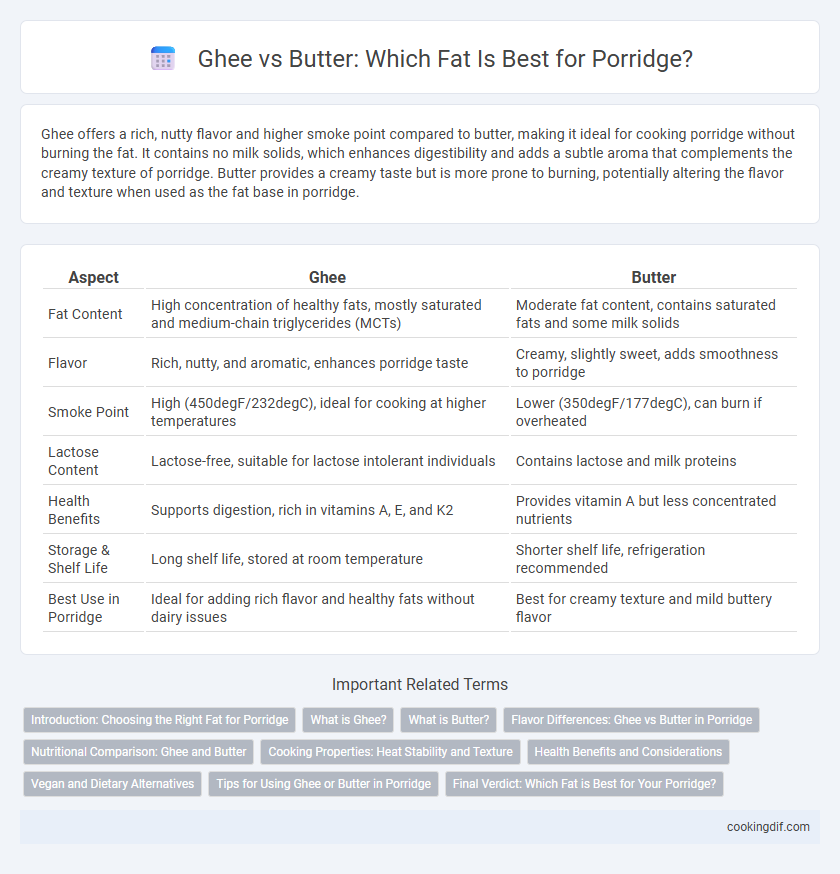Ghee offers a rich, nutty flavor and higher smoke point compared to butter, making it ideal for cooking porridge without burning the fat. It contains no milk solids, which enhances digestibility and adds a subtle aroma that complements the creamy texture of porridge. Butter provides a creamy taste but is more prone to burning, potentially altering the flavor and texture when used as the fat base in porridge.
Table of Comparison
| Aspect | Ghee | Butter |
|---|---|---|
| Fat Content | High concentration of healthy fats, mostly saturated and medium-chain triglycerides (MCTs) | Moderate fat content, contains saturated fats and some milk solids |
| Flavor | Rich, nutty, and aromatic, enhances porridge taste | Creamy, slightly sweet, adds smoothness to porridge |
| Smoke Point | High (450degF/232degC), ideal for cooking at higher temperatures | Lower (350degF/177degC), can burn if overheated |
| Lactose Content | Lactose-free, suitable for lactose intolerant individuals | Contains lactose and milk proteins |
| Health Benefits | Supports digestion, rich in vitamins A, E, and K2 | Provides vitamin A but less concentrated nutrients |
| Storage & Shelf Life | Long shelf life, stored at room temperature | Shorter shelf life, refrigeration recommended |
| Best Use in Porridge | Ideal for adding rich flavor and healthy fats without dairy issues | Best for creamy texture and mild buttery flavor |
Introduction: Choosing the Right Fat for Porridge
Ghee offers a rich, nutty flavor and higher smoke point, making it ideal for cooking porridge without burning the fat. Butter provides a creamy texture and subtly sweet taste but can brown quickly at high heat. Selecting ghee or butter for porridge depends on desired flavor intensity, cooking method, and nutritional preferences.
What is Ghee?
Ghee is clarified butter made by simmering butter to remove water content and milk solids, resulting in a rich, nutty flavor ideal for enhancing porridge. Unlike regular butter, ghee has a higher smoke point, making it more stable during cooking and less likely to burn when added to hot porridge. Its lactose-free and longer shelf life qualities also make ghee a preferred fat for creamy, flavorful porridge.
What is Butter?
Butter is a dairy product made by churning cream, resulting in a creamy, rich fat commonly used to enhance the texture and flavor of porridge. It contains about 80% fat, with the remainder being water and milk solids, which contribute to its distinct taste and slightly lower smoke point compared to ghee. Unlike ghee, butter retains milk solids that can caramelize during cooking, adding a subtle sweetness and creaminess to porridge.
Flavor Differences: Ghee vs Butter in Porridge
Ghee imparts a rich, nutty flavor with caramelized undertones that enhance the taste profile of porridge, while butter offers a creamier, more delicate richness with subtle dairy notes. The lack of milk solids in ghee prevents burning, allowing for a deeper toasted taste when incorporated into porridge. Choosing ghee results in a more robust, aromatic experience, whereas butter contributes a smoother, milder flavor.
Nutritional Comparison: Ghee and Butter
Ghee contains a higher concentration of fat-soluble vitamins A, D, E, and K compared to butter, making it a nutrient-dense option for porridge enrichment. Butter typically has more lactose and milk solids, which can affect digestion for some individuals, whereas ghee is clarified and free from these components. Both fats provide saturated fatty acids, but ghee offers a longer shelf life and a richer flavor profile, contributing to enhanced nutritional and sensory qualities in porridge.
Cooking Properties: Heat Stability and Texture
Ghee offers superior heat stability compared to butter, making it ideal for cooking porridge at higher temperatures without burning or smoking. Its clarified nature provides a smooth, rich texture that enhances the creaminess of porridge, whereas butter may separate and create a less uniform consistency. Choosing ghee ensures a stable cooking fat that maintains flavor and texture integrity throughout porridge preparation.
Health Benefits and Considerations
Ghee offers a higher smoke point and contains beneficial medium-chain fatty acids that support digestion and promote anti-inflammatory effects, making it a healthier fat option for porridge. Butter provides a rich source of fat-soluble vitamins like A, D, and E but has a lower smoke point and contains lactose, which may not be suitable for lactose-intolerant individuals. Choosing ghee over butter can enhance porridge's nutritional profile by improving digestibility and reducing potential allergenic reactions.
Vegan and Dietary Alternatives
Ghee provides a rich, nutty flavor and is lactose-free but not suitable for vegans due to its dairy origin. Butter offers a creamy texture but contains dairy and lactose, limiting its use for those with dietary restrictions or vegan preferences. Plant-based oils like coconut or avocado oil serve as ideal vegan and dietary alternatives, enhancing porridge with healthy fats and a subtle flavor profile.
Tips for Using Ghee or Butter in Porridge
Ghee enhances porridge with a rich, nutty flavor and higher smoke point, making it ideal for cooking at higher temperatures without burning. Butter adds a creamy texture and subtle sweetness but requires careful heat control to prevent browning. For optimal taste, swirl a teaspoon of ghee or butter into the warm porridge just before serving to preserve its aroma and smooth consistency.
Final Verdict: Which Fat is Best for Your Porridge?
Ghee offers a higher smoke point and richer nutty flavor, enhancing the texture and taste of porridge without burning during cooking. Butter provides creaminess and a slightly sweet taste but can scorch easily at higher temperatures. For nutrient retention and cooking stability, ghee is the optimal fat choice for preparing porridge.
Ghee vs Butter for Porridge Fat Infographic

 cookingdif.com
cookingdif.com